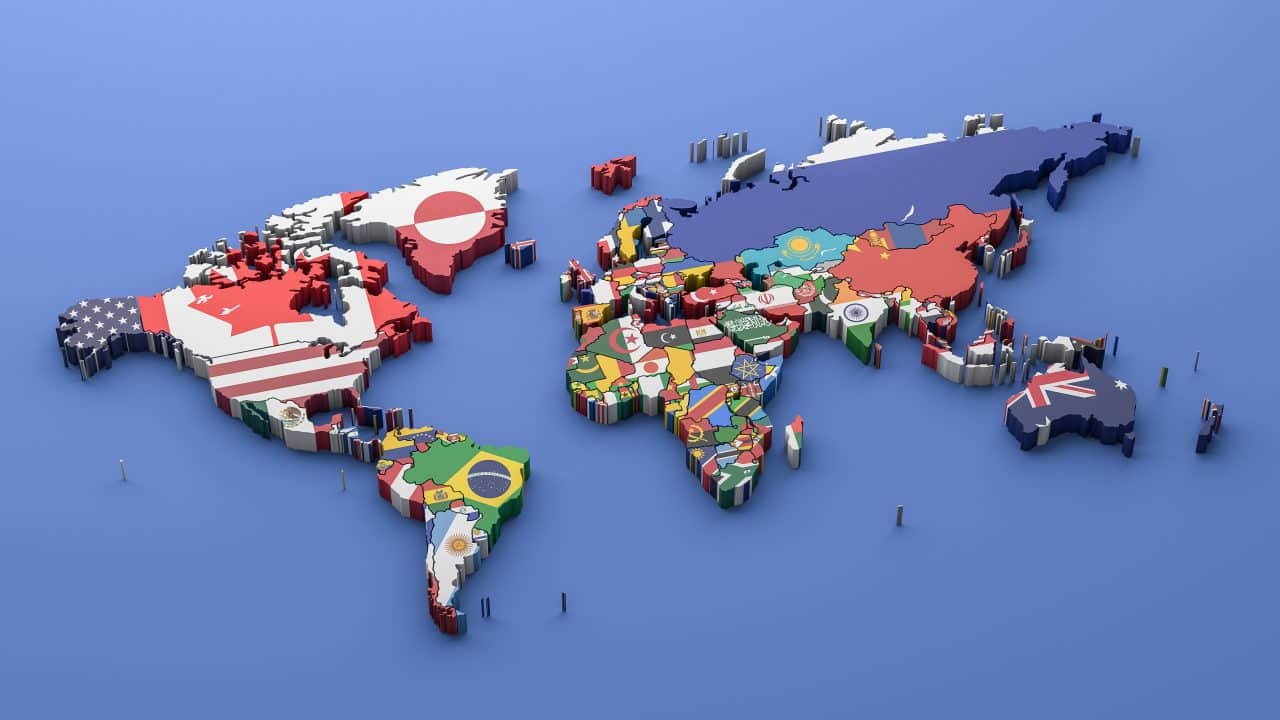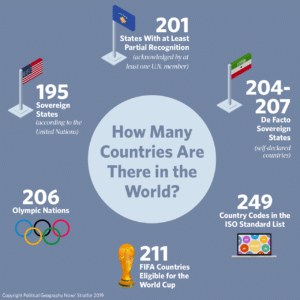How Many Countries Are There in This World? The Ultimate Breakdown
Introduction
Understanding the number of countries in the world is critical. It’s not just about memorizing facts; It’s about understanding the complexity of our global community. Each country represents a unique blend of culture, history and identity, forming the fabric of humankind.
Join us as we explore territorial politics, tour disputed territories, and explore complex issues of sovereignty. Our goal is to shed light on this important part of our world, providing insights that will expand your understanding and appreciation of our diverse planet. Together we embark on this enlightening journey.
What defines a nation?
Understanding what defines a country is key to determining the number of countries in the world. There are some basic criteria that determine whether a region qualifies as a state or not.
- Sovereignty: A state should have absolute control and sovereignty over its internal and external affairs without interference from other states.
- Recognition by other states: Although declaration is key, international recognition by other states plays an important role in establishing sovereignty
- Territorial Strategies: Countries have defined boundaries defining their territory from neighboring countries.
- Permanent Population: A country must have a permanent population living within its borders.
- Government: The states have a functional government or authority that controls the population and governs the territory.
- Ability to establish relations with other states: States have the ability to establish diplomatic relations and enter into treaties with other sovereign states
Current Count of Countries
Understanding the current count of countries in the world is essential for grasping the global geopolitical landscape. Here’s an overview of the total number of recognized countries today and factors influencing this count:
- Total Number: As of [current year], there are [insert number] recognized countries in the world. These countries vary in size, population, and political systems.
- Variability: The number of countries can fluctuate due to political changes, disputes, and international recognition. New countries may emerge through secession or declaration of independence, while others may merge or dissolve through political agreements.
- Political Changes: Geopolitical events such as revolutions, coups, or constitutional reforms can lead to changes in the number of countries. For example, the breakup of the Soviet Union and Yugoslavia resulted in the emergence of several new countries in the early 1990s.
- Disputes and Recognition: Disputed territories and regions aspiring to statehood contribute to the variability in the count of countries. These regions often face challenges in gaining international recognition due to geopolitical tensions and conflicting territorial claims.
The Role of International Organizations
Understanding the significance of membership in international organizations provides insight into a territory’s status as a country. Here’s an overview:
- United Nations (UN): Membership in the United Nations is a crucial factor in determining a territory’s recognition as a sovereign state. UN membership grants legitimacy and facilitates diplomatic relations with other member states.
- Other International Bodies: Besides the UN, various international organizations play a role in recognizing countries and shaping global politics. Organizations such as the European Union (EU), African Union (AU), and Organization of American States (OAS) may influence a territory’s status through membership or diplomatic engagement.
- Recognition and Diplomacy: International recognition by other countries and diplomatic relations contribute to a territory’s legitimacy as a sovereign state. Membership in international organizations enhances a territory’s ability to engage in global affairs and advocate for its interests on the international stage.
Economic impact of national recognition
Understanding the economic implications of state recognition examines the benefits and challenges faced by sovereign states. Here is an analysis of these indicators:
-
The benefits:
○ Trade agreements: Recognized countries can enter into trade agreements with other countries, facilitating international trade and economic cooperation.
○ Access to international aid: Sovereign states can access international aid and development assistance, which can support economic growth and infrastructure development.
○ Information: Internationalization enables countries to engage in bilateral and multilateral partnerships, enhancing opportunities for economic partnerships and investments.
- Errors:
○ Trade barriers: Unrecognized territories may face trade barriers and restrictions, limiting their participation in international trade and economic exchange.
○ Limited access to aid: Without international recognition, local communities may struggle to access humanitarian and development assistance, hindering their socio-economic development.
○ Diplomacy: Lack of recognition can lead to international isolation, making it harder to establish diplomatic relations and enter into economic agreements with other nations.
The challenges of control
Examining the challenges of sovereignty reveals the difficult dynamics that states have to maintain their independence and autonomy. Here is an analysis of these challenges:
- Internal conflict: Ethnic, religious and political conflicts within a country can undermine its stability and sovereignty, leading to communal violence and internal conflict
- Border conflicts: Territorial disputes with neighboring countries pose significant challenges to sovereignty, often resulting in interstate conflicts and, in some cases, military conflicts
- External pressure: The influence of foreign powers, regional conflicts, or international organizations can put pressure on a country’s sovereignty, restricting its ability to make independent decisions.
- Separatism: Independent areas may challenge the sovereignty of a state, leading to demands for autonomy or secession.
- Globalization: Increasing interconnectedness and interdependence in the global economy creates challenges for sovereignty, as countries undertake deep economic, social and political development den in the no
cultural and ethnic diversity
Cultural and ethnic diversity plays an important role in shaping the identities and borders of nations. How to find out:
- Cultural identity: Culturally diverse areas often aspire to autonomy or autonomy in order to preserve their unique cultural heritage and traditions.
- Autonomy movements: Ethnic minorities can seek self-government to protect their cultural identity and language. Examples include the Basque Country in Spain and the Quebec separatist movement in Canada.
- Preservation of cultural heritage: Diverse societies can implement policies to promote cultural diversity and preserve cultural diversity. These efforts are helpful.
Technological Advances and Virtual States
Advancements in technology have revolutionized the concept of sovereignty, leading to the emergence of virtual states and online communities. Here’s how:
- Virtual States: Online platforms and social media have enabled the formation of virtual states, where individuals from different geographical locations unite under a common identity or ideology.
- Cyber Sovereignty: Virtual states challenge traditional notions of sovereignty by transcending physical borders and jurisdictional boundaries. They raise questions about governance and legal frameworks in the digital age.
- Digital Citizenship: Citizens of virtual states may enjoy rights and privileges in the virtual realm, such as access to virtual economies and participation in online governance structures.
- Challenges to Sovereignty: The rise of virtual states poses challenges to traditional nation-states, as they may undermine the authority of governments and blur the lines between physical and digital territories.
The Role of Geopolitics
Geopolitical factors wield significant influence in determining the recognition of countries and shaping global affairs. Let’s delve into the intricacies:
- Alliances and Diplomacy: Countries often form alliances and engage in diplomatic relations to advance their interests and bolster their geopolitical standing. These alliances can impact the recognition of countries and their legitimacy on the international stage.
- Strategic Interests: Strategic considerations, such as access to resources, military positioning, and economic opportunities, influence the recognition of countries. Powerful nations may support or oppose the recognition of certain territories based on their strategic interests.
- Power Dynamics: Power dynamics between nations play a crucial role in determining the recognition of countries. Dominant powers exert influence over weaker states, shaping their foreign policies and alliances.
Environmental Challenges and Sovereignty
Environmental challenges pose complex issues for sovereignty, affecting territorial integrity and resource management. Here’s an exploration:
- Climate Change: Rising sea levels, extreme weather events, and changing climatic patterns can threaten coastal nations and island states, impacting their territorial sovereignty. Small island nations, such as the Maldives and Tuvalu, face existential threats from climate change-induced sea level rise.
- Natural Disasters: Natural disasters, such as hurricanes, earthquakes, and wildfires, can devastate countries and challenge their ability to govern effectively. Recovery efforts may require international assistance and cooperation, blurring the lines of sovereignty.
- Shared Resources: Transboundary environmental issues, such as water scarcity and pollution, can lead to disputes over shared resources between countries. Managing these resources requires cooperation and diplomacy to ensure equitable distribution and sustainable development.
- Environmental Degradation: Environmental degradation, including deforestation, desertification, and loss of biodiversity, can undermine a country’s sovereignty by threatening its ecological resilience and economic stability.
Human Rights and Sovereignty
The relationship between human rights and sovereignty is complex and often fraught with tension. Here’s an exploration:
- Inherent Dilemma: Sovereignty emphasizes a nation’s right to govern itself without external interference. However, this principle can clash with the international community’s obligation to uphold human rights standards.
- International Interventions: In cases where governments violate the human rights of their citizens, the international community may intervene, challenging the principle of sovereignty. Examples include humanitarian interventions, peacekeeping missions, and sanctions aimed at protecting human rights.
- Responsibility to Protect (R2P) Doctrine: The R2P doctrine asserts that the international community has a responsibility to intervene when a state fails to protect its citizens from genocide, war crimes, ethnic cleansing, and crimes against humanity. This doctrine emphasizes the primacy of human rights over sovereignty.
conclusion
In conclusion, understanding states, regions and power dynamics is important in the complexity of global politics. We examined a range of areas, from geopolitics to human rights considerations, shedding light on the ever-changing landscape of international relations. As a global community, it is important that we remain informed and engaged, address pressing challenges and encourage dialogue and cooperation to create a more just and peaceful world.



